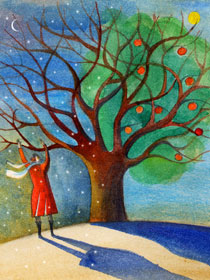Issue Archive
Commentary: The Jewish Earth Day

Midwinter is not a logical time for a holiday celebrating trees. It is a time when most trees lie dormant—and most kids today won’t go sloshing through the ice and snow to admire them, much less to plant them.
How could our ancestors have planned Tu Bishvat, the “birthday” of the trees, for such an inconvenient season?
They didn’t. The meaning of Tu Bishvat (the 15th day of the Hebrew month of Shvat) has evolved over the centuries. Today, it is an awkwardly timed opportunity for Hebrew-school children to taste the woody carob fruit. But it didn’t start out as a planting holiday—or any kind of holiday. For our ancestors, it was tax-collecting time. In midwinter, the tax collector in ancient Israel trudged from village to village assessing the fruit trees. Those that had bloomed before Tu Bishvat were assessed for the previous year; those that hadn’t would be taxed a year later.
Our ancestors didn’t need a holiday to remind them to be grateful for the land’s generosity. They brought thank you gifts, the fruit of the earth, to the Temple in Jerusalem on the pilgrimage holidays of Sukkot, Pesah and Shavuot.
After the destruction of the Temple and our dispersal from the land, Tu Bishvat was ignored for centuries. It was revived by Jewish mystics who returned to northern Israel in the 16th century. For them, Tu Bishvat became a time of reunification of God and His creatures. In Safed’s snowy hills, they held a festive seder with four cups of wine, dried fruit, songs and prayer.
In modern Israel, the day changed into a time to plant trees as Jewish pioneers sought to build a new state. It became intertwined in the mythology of a green Israel, even if it meant planting in the rainy season. In Israel and around the world, children began celebrating a Jewish Arbor Day.
I believe it is time for Tu Bishvat to change again. We must expand our celebration to embrace the whole earth. We must make it a time to sharpen our appreciation—in our urban, high-technology settings—of God’s gifts to us and all living creatures. The fruit tree has always been the star of Tu Bishvat celebrations, but what about the way the rest of the earth has generously sustained us for centuries?
In Genesis 2:15, God put man into the Garden of Eden and directed him “to work it and care for it.” We use the earth in countless ways—to dig for fuel, drain for water, chop down its forests and use its living creatures for our own purposes, even as we pour trash and pesticides into the sea and onto the land. But we are not tending it. The once beautiful earth is responding in frightening ways, with shrinking supplies of pure water, growing deserts and disappearing species.
There are a thousand ways to protect the earth, from conservation of resources and recycling at home to demanding the government change its policies to encourage conservation. Of the many organizations that can guide us, check out the Coalition on the Environment and Jewish Life (www.coejl.org). The cumulative effect of small changes can have a profound effect on our world. It is time for us to nurse our planet back to health, coaxing the earth to bloom into the paradise that God created.
Here are some fun ways to celebrate the holiday and enjoy the earth:
- Explore the woods. Look for animal tracks in snow or mud. Use a handbook to identify trees. Build a campfire to roast marshmallows.
- Build a bird feeder and keep it filled.
- Have a feast with dried and fresh fruits and nuts. Read poetry and say prayers of thanks.
- Plant a tree in Israel through the Jewish National Fund (www.jnf.org).
Till the earth and tend it.
Chaya Burstein is author of A Kid’s Catalog of Animals and the Earth (Jewish Publication Society).










 Facebook
Facebook Instagram
Instagram Twitter
Twitter
Leave a Reply